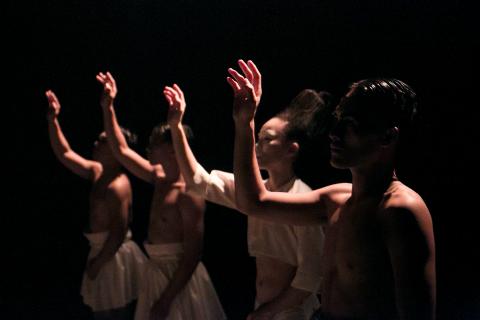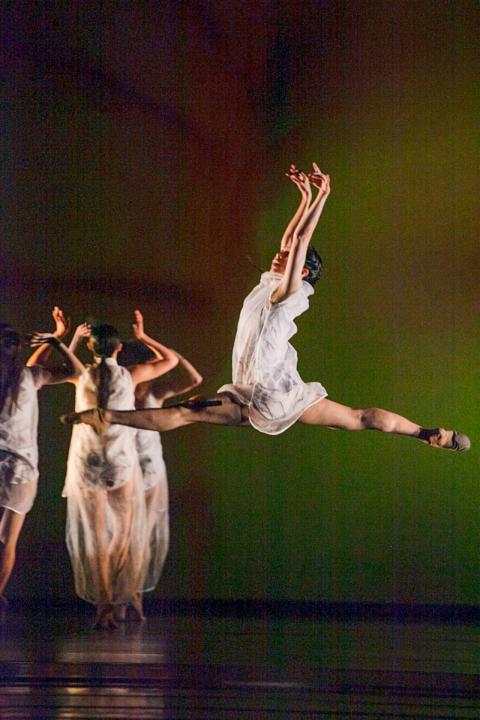It was a year with plenty of highs and a few lows — and plenty of weekends when Taipei’s dance audiences were overloaded with choices, so selecting the truly outstanding shows was a tough job and it proved impossible to see everything.
It was also a year of unexpected surprises, and one that proved very good for the nation’s mid-sized choreographers and companies as well as the National Theater Concert Hall (NTCH), where the annual Taiwan International Festival of Arts won at lot of applause.
The biggest surprise came in early June, when choreographer Kader Attou’s Compagnie Accrorap made its Taiwan premiere at the National Sun Yat-sen Memorial Hall with Attou’s 2013 production, The Roots. I am embarrassed to admit my bias was showing when I turned up for the 70-minute hip-hop piece; I was not expecting a lot and ended up being blown away.

Photo courtesy of Tjimur Dance Theatre
The Roots grabs viewers’ attention from the opening scene and Attou’s creativity, the fluidity of his 11 male dancers, as well as a beautiful score by Regis Baillet-Diaphane all made for a terrific show — even if it seemed a tad too long — and left me longing to see more of Attou’s works.
One of the best works of the year was Leipzig Ballet artistic director and choreographer Mario Schroder’s Wild Butterflies (狂放的野蝶), created for Century Contemporary Dance Company (CCDC, 世紀當代舞團) as part of a joint program for the NTCH festival in April. The show included a revival of CCDC founder Yao Shu-fen’s (姚淑芬) powerful Les Noces (婚禮) and an extract of Schroder’s Ein Liebestraum (A Dream of Love) performed by his Leipzig dancers. Wild Butterflies (狂放的野蝶) owed its power to both Schroder’s choreography and to the beautiful videography of Chang Hao-jan (張皓然).
It was a good year for Dance Forum Taipei (舞蹈空間), whose third collaboration with Spanish choreographer Marina Mascarell, it is like a large animal deep in sleep (沉睡的巨獸), was another winner. The show at Huashan 1914 Culture Park in mid-May featured a multitude of cardboard boxes and posed a lot of questions, but it proved as entertaining as it was thought provoking.

Photo courtesy of National Theater Concert Hall
The troupe’s second joint production, Hui (迴) — a collaboration with Amsterdam-based Anmaro Asia Arts, Glasgow-based Cryptic, New York City-based Chinese composer Tan Dun (譚盾), Taiwanese choreographer Yang Ming-lung (楊銘隆) and Netherlands-based Spanish choreographer Ivan Perez Aviles — was visually stunning, but not as cohesive or strong as Mascarell’s piece.
However, hers had the benefit of having “marinated” for several months, having begun life as a three-dancer piece for Skanes Dansteater last year, which raises hopes that Hui reaches its full potential when it goes on a scheduled tour in Europe in 2017.
Among the other highlights was Cloud Gate 2’s (雲門 2) Spring Riot program: Horde (暫時而已) by Huang Huai-te (黃懷德), Hell Groove (衝撞天堂) by Chen Yun-ju (陳韻如) and artistic director Cheng Tsung-lung’s (鄭宗龍) Beckoning (來) at the new Cloud Gate Theater/Tamsui Culture and Art Education Center (淡水文化藝術教育中心) in New Taipei City’s Tamsui District (淡水) were all good works and the troupe looked better than ever.
Cloud Gate 2’s first resident choreographer, Bulareyaung Pagarlava, made a strong showing with his new Taitung-based troupe, the Bulareyaung Dance Company (布拉瑞揚舞團台北首演), at the Tamsui venue with La Ke (拉歌) in July.
Ho Hsiao-mei’s (何曉玫) Camouflage (假裝) at the National Theater in June was great, with an innovative set and stage design that took full advantage of the big stage to show her Meimage Dance (玫舞擊) troupe to their best advantage. It is a piece I would love to see again, as was T.T.C. Dance’s (張婷婷獨立製作) Body Platform: Persistence of Memory (肢‧色系列2:時空抽屜) show at the Experimental Theater in August. Despite the cramped space, Chang Ting-ting (張婷婷) made use of an unusual set that helped blur the boundaries between her dancers and 3D projections.
Just when Taipei dance fans might have thought they had seen everything, last weekend produced two final delights, both from southern Taiwan. It was good to see Benson Tsai’s (蔡博丞) new B.DANCE (丞舞製作團隊) troupe at the Shuiyuan (Wellspring) Theater and his attempt at a full-length piece, but as fun as Floating Flowers II (浮花) was to watch, it needs trimming because it is too reliant upon a driving score and pop-art videography to keep the audience’s interest.
However, Tjimur Dance Theatre’s (蒂摩爾古薪舞集) 似不舞[s] (As Four Step) at the Experimental Theater proved the power and beauty of simplicity. Baru Madiljin’s minimalist choreography is highlighted by simple white costumes and monochromatic staging, and the piece was simply wonderful to watch. My only complaint is that the show was the first time I had ever seen the nine-year-old company and now I know just how much I have been missing.
It was also a year to say a very unwilling goodbye. The magnificent French dancer Sylvie Guillem, whose “Life in Progress” tour closes the door on her storied career as of today, thankfully added two Taipei dates to her already full schedule, and she was as amazing and mesmerizing as ever.

We lay transfixed under our blankets as the silhouettes of manta rays temporarily eclipsed the moon above us, and flickers of shadow at our feet revealed smaller fish darting in and out of the shelter of the sunken ship. Unwilling to close our eyes against this magnificent spectacle, we continued to watch, oohing and aahing, until the darkness and the exhaustion of the day’s events finally caught up with us and we fell into a deep slumber. Falling asleep under 1.5 million gallons of seawater in relative comfort was undoubtedly the highlight of the weekend, but the rest of the tour

Youngdoung Tenzin is living history of modern Tibet. The Chinese government on Dec. 22 last year sanctioned him along with 19 other Canadians who were associated with the Canada Tibet Committee and the Uighur Rights Advocacy Project. A former political chair of the Canadian Tibetan Association of Ontario and community outreach manager for the Canada Tibet Committee, he is now a lecturer and researcher in Environmental Chemistry at the University of Toronto. “I was born into a nomadic Tibetan family in Tibet,” he says. “I came to India in 1999, when I was 11. I even met [His Holiness] the 14th the Dalai

Following the rollercoaster ride of 2025, next year is already shaping up to be dramatic. The ongoing constitutional crises and the nine-in-one local elections are already dominating the landscape. The constitutional crises are the ones to lose sleep over. Though much business is still being conducted, crucial items such as next year’s budget, civil servant pensions and the proposed eight-year NT$1.25 trillion (approx US$40 billion) special defense budget are still being contested. There are, however, two glimmers of hope. One is that the legally contested move by five of the eight grand justices on the Constitutional Court’s ad hoc move

Stepping off the busy through-road at Yongan Market Station, lights flashing, horns honking, I turn down a small side street and into the warm embrace of my favorite hole-in-the-wall gem, the Hoi An Banh Mi shop (越南會安麵包), red flags and yellow lanterns waving outside. “Little sister, we were wondering where you’ve been, we haven’t seen you in ages!” the owners call out with a smile. It’s been seven days. The restaurant is run by Huang Jin-chuan (黃錦泉), who is married to a local, and her little sister Eva, who helps out on weekends, having also moved to New Taipei